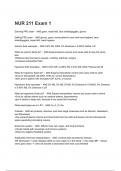NUR 211 Exam 1
Donning PPE order - ANS gown, mask/n95, face shield/goggles, gloves
Doffing PPE order - ANS gloves, gown, leave patient's room and hand hygiene, face
shield/goggles, mask/n95, hand hygiene
Isotonic fluid examples - ANS 0.9% NS, D5W, 5% Dextrose in 0.225% Saline, LR
What do isotonic fluids do? - ANS Expand plasma volume and cause cells to stay the same
size
-Replaces fluid lost due to nausea, vomiting, diarrhea, surgery
-increases extracellular fluid
Hypotonic fluid examples - ANS 0.45% NS, 0.225% NS, 0.33% NS, D5W, Plasma lyte 56
What do hypotonic fluids do? - ANS Expand intracellular volume and cause cells to swell
-Give for dehydrated cell (DKA, HHS, DI, severe dehydration)
-don't give to patient with increased ICP, burns, or trauma
Hypertonic fluid examples - ANS 3% NS, 5% NS, D10W, 5% Dextrose in 0.9%NS, 5% Dextrose
in 0.45% NS, 5% Dextrose in LR
What do hypertonic fluids do? - ANS Expand extracellular volume and cause cells to shrink
-Give for cellular edema such as cerebral edema, hyponatremia
-give it slowly in large vein, because it can cause fluid overload
What electrolytes are in LR? - ANS Ca, K, Cl, Na
Colloids - ANS are proteins, starches, and other large molecules such as Albumin, Hetastarch,
and Plasmalyte
-they expand plasma volume and draw fluids from the cells and tissues into the intravascular
space expanding circulating volume.
Endocrine system - ANS -Affects most cell, organ, and body functions
-Closely linked with neurologic and immune systems
-Works by negative feedback system
Antidiuretic Hormone (Vasopressin) - ANS -Controls fluid excreted by kidneys
-BP decreased -> body releases ADH so more water is in the blood -> this raises BP -> blood
osmo goes down -> urine we excrete is decreased and more concentrated
,Normal blood osmolality - ANS 275-295 mOsm/kg
Normal urine osmolality - ANS 500-850 mOsm/kg
Diabetes Insipidus (DI) - ANS DRY DAN
-Hyposecretion of ADH or failure of kidney to respond appropriately to ADH
-Large Volume of dilute urine*
-Associated- Neurogenic or Nephrogenic- failure of kidney to respond appropriately to ADH/ pee
a lot
-polyurea/ nothing to do with blood sugar
-lose large volume of dilute urine 4-30 L in 24 hrs
-associated with neurogenic (hyposecretion- swelling of the brain, tumor in the brain, infection of
the brain, surgery) and nephrogenic (hypokalemia, hypercalcemia, meds like lithium kidneys
less responsive) become dehydrated
-Dry patient because urinating lots of water
-Hypernatremia can occur
DI Diagnostics - ANS -Fluid Deprivation Test: 8-12 hrs or until 3-5% of body weight is lost/
person is weighed frequently
-Plasma and urine osmolality studies performed/ Inability for the specific gravity to increase is
characteristic of DI
-ADH test: measures how much ADH is in the blood usually used in combination with other tests
to determine what is causing the increase or decrease in ADH levels/ The increase in urine
osmolality and decreased urine output with this test is characteristic of DI
-Urine specific gravity for DI is < 1.006
-Hold meds with sucrose or dextrose
-No heavily dyed foods before test
DI clinical manifestations - ANS -UOP- 4-30 L/day
-Tachycardia
-Polydipsia
-Neuro changes
-Serum Osmolality ↑
-Urine Osmolality ↓
-Na levels ↑
-Hypotension
-Cardiovascular collapse
-dehydration in vascular bed
-Hypovolemia
-Decreased BP
DI Medical Management - ANS -Replace Fluids: Free water- drinking water, water through ng
tube or iv fluids, d5w and water
, -Neurogenic (brain)- not enough ADH/ give IV vasopressin and desmopressin nasal spray (it
causes vasoconstriction so careful with heart patients), give thiazide diuretics (increased sun
sensitivity and hypokalemia and hypomagnesemia) Chlorpropamide
-Thiazide Diuretics- makes desmopressin work harder
-Renal- have enough ADH just not responding/ give thiazide diuretics, mild salt depletion,
prostaglandin inhibitors- ibuprofen, aspirin- watch bleeding
-Prostaglandin inhibitors- help kidney respond better to diuretic and vasopressin (indomethacin)
Which prescription for a client diagnosed with diabetes Insipidus should the nurse question?
A. Monitor and record accurate intake and output
B. Check urine specific gravity
C. Restrict fluids to 100ml every 6 hours
D. Weigh the client daily - ANS C
Syndrome of Inappropriate Antidiuretic Hormone (SIADH) - ANS SOGGY SAM
-Excess secretion of ADH
-Concentrated urine
-Dilutional hyponatremia
-Fluid overload signs and symptoms
-Associated with neurological trauma, swelling of the brain, tumors of brain and lung,
pneumonia and meningitis (infections)
-Meds- vincristine, thiazide diuretics, phenothiazines, tricyclic antidepressants
-very concentrated urine, hang on to water, hyponatremia, fluid overload signs and symptoms
SIADH Diagnostics - ANS -Urine specific gravity > 1.032
-Serum Osmolality ↓
-Urine Osmolality ↑
-Serum Na ↓
-BUN/CR ↓
SIADH clinical manifestations - ANS Fluid overload signs and symptoms hypertension,
crackles, jvd, edema, altered loc, seizures, coma, and death
-Na levels below 120- seizure, coma death
SIADH Medical Management - ANS -Treat underlying cause
-Fluid Restrictions- no free water
-Na supplementation: Hypertonic solutions 3% NS- give in large vein/ central line/ give slowly/ or
Orally- like salt tabs
-Loop diuretics- furosemide- pull fluid to kidney and pee it out
-Electrolyte replacements
-least to most invasive procedures
SIADH Nursing Interventions - ANS -Monitor cardiac and Neuro
-I & O




